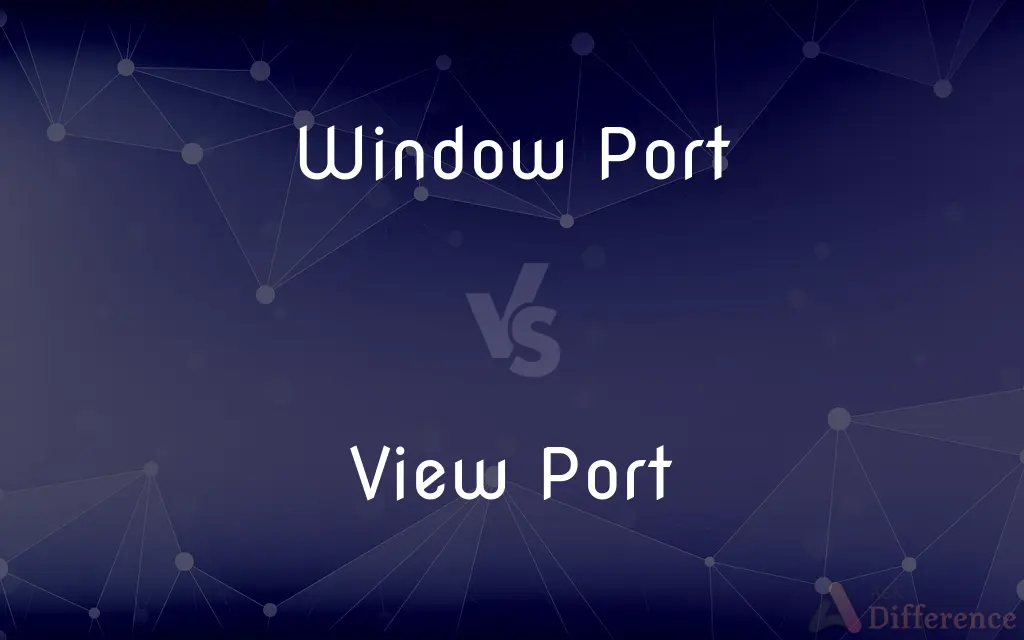Window Port vs. View Port — What's the Difference?
By Tayyaba Rehman — Published on December 13, 2023
Window Port is the entire graphical area of an application, while View Port defines a subset or specific viewing area within it.

Difference Between Window Port and View Port
Table of Contents
ADVERTISEMENT
Key Differences
A Window Port, in graphical user interfaces, refers to the entire visual area of a computer application or software. This might encompass everything you see when you open a program, from the top title bar to the status bar at the bottom. In essence, it represents the overall workspace that a user interacts with. Think of the Window Port as the whole canvas where various elements and components of an application reside.
In contrast, a View Port pertains to a specific area within that Window Port. It delineates a part of the content that's currently visible to the user. When dealing with graphics or design applications, or even web browsers, not all content can fit into the visual area at once. That's where the View Port comes in—it defines which part of that content the user is currently viewing or interacting with.
Window Port and View Port often work together in harmony, especially in applications that deal with vast amounts of data or content. For instance, when scrolling through a long document or web page, the Window Port remains static—its size and position are unchanged. Meanwhile, the View Port shifts, moving along the content, revealing different sections of it to the user.
Another analogy can be made by considering the Window Port as the frame of a painting, dictating its boundaries, while the View Port is like the magnifying glass focusing on specific details within that frame. It's essential to understand the dynamic between Window Port and View Port, especially for designers and developers, to create user-friendly interfaces.
Comparison Chart
Definition
Entire visual area of an application
Specific visible area within the Window Port
ADVERTISEMENT
Function
Defines application's boundaries
Dictates what content is currently being viewed
Size and Position
Typically remains static
Can change based on user interaction
Interaction
Houses various application components
Focuses on specific content details
Analogy
Canvas or frame of a painting
Magnifying glass highlighting details in the painting
Compare with Definitions
Window Port
Window Port sets the boundaries for graphical user interfaces.
The Window Port of a graphics software determines where tools and menus are placed.
View Port
View Port represents a portion of content currently visible within the Window Port.
In a mapping application, the View Port shows a specific geographical area.
Window Port
Window Port is static during user interaction.
Scrolling through a document doesn't change the Window Port, only the content within.
View Port
View Port interacts dynamically with content.
In video editing, the View Port might showcase a specific timeline segment.
Window Port
Window Port houses both content and interactive elements.
In a browser, both the address bar and the webpage are part of the Window Port.
View Port
View Port can shift based on user actions.
When scrolling on a website, the View Port moves to display different sections.
Window Port
Window Port is the total visual area of a computer application.
When launching a word processor, the entire screen space it occupies is the Window Port.
View Port
View Port's size can be adjusted in some applications.
Split-screen modes in design software adjust the View Port to show multiple content sections.
Window Port
Window Port encompasses all visible elements in an application.
Adjusting the size of the application changes the dimensions of the Window Port.
View Port
View Port acts as a lens focusing on certain application details.
Zooming into an image changes the View Port to focus on finer details.
Common Curiosities
Can the View Port be larger than the Window Port?
No, the View Port is always a subset or equal to the Window Port, showing only a part or all of its content.
What is a Window Port in graphical interfaces?
A Window Port refers to the entire visual area or boundary of a computer application or software.
How does View Port differ from Window Port?
While Window Port is the total visual area of an app, View Port represents a specific, visible section within that area.
Is the Window Port affected when I scroll through a document?
No, scrolling affects the View Port, showing different content sections, but the Window Port remains unchanged.
How are Window Port and View Port relevant to web design?
Understanding them helps designers create responsive designs, ensuring content is displayed correctly across devices.
Does resizing an application window affect the Window Port?
Yes, resizing the window adjusts the Window Port's dimensions, possibly affecting the View Port as well.
Is the View Port static in applications?
No, the View Port can change based on user interactions like scrolling, zooming, or panning.
Can there be multiple View Ports within a Window Port?
Yes, in certain applications like design software, multiple View Ports can exist within a single Window Port.
How does View Port affect user experience?
A well-defined View Port ensures users can easily view and interact with essential content without being overwhelmed.
Can the View Port be manipulated via code?
Yes, developers can use code to define and adjust the View Port, especially in web design.
Is every part of an application's screen the Window Port?
Yes, the Window Port encompasses the entire visual area, including menus, toolbars, and content.
Why is understanding the View Port crucial for developers?
It helps in creating interfaces that adjust content based on device size and user interactions, improving usability.
Are Window Port and View Port terms exclusive to computer graphics?
Primarily, but they might be used in other contexts with slightly different meanings.
Does zooming in on an image affect the Window Port?
No, zooming affects the View Port by focusing on specific image details, but the Window Port stays constant.
Do mobile devices have Window Ports and View Ports?
Yes, both terms apply to mobile devices, with View Port adjustments being crucial for responsive design.
Share Your Discovery

Previous Comparison
Ethanol vs. Ethanoic Acids
Next Comparison
Taglines vs. SlogansAuthor Spotlight
Written by
Tayyaba RehmanTayyaba Rehman is a distinguished writer, currently serving as a primary contributor to askdifference.com. As a researcher in semantics and etymology, Tayyaba's passion for the complexity of languages and their distinctions has found a perfect home on the platform. Tayyaba delves into the intricacies of language, distinguishing between commonly confused words and phrases, thereby providing clarity for readers worldwide.












































